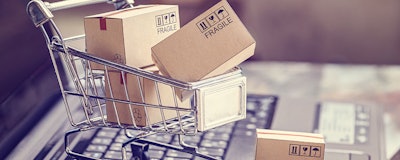
 Sage ERP
Sage ERPThe first modern online order was placed in 1994 by a man in Philadelphia who bought Sting’s Ten Summoner’s Tales album from a friend for $12.48 (plus shipping, of course). Since then, the way we shop has changed radically. Today’s consumer is no longer restricted to a physical store, or even to traditional business hours — they can shop from practically wherever, whenever they want. And because of this freedom, they’ve come to expect a few things: easy ordering, seamless fulfillment and delivery and hassle- (and cost) free returns.
To keep up, brands have had to adjust and integrate their supply chains from end-to-end — quickly. Because of the ease of shopping from anywhere, they have also been forced to be everywhere, and are using technology to meet the high expectations of consumers all over the world.
E-Commerce is More Than Just Setting Up a Website
In today’s interconnected world, brands of all sizes must operate globally. And while it may seem easy for a brand to set up a website and offer shipping worldwide, in order to be successful in the long run they must invest in the overall e-commerce experience. This means paying attention to everything from the website’s look and feel, to translating the site into multiple languages, to accepting location-specific currencies and payment methods (despite what it may seem, not everyone today has a credit card!).
It also means choosing the right e-commerce partner that can manage how your product is sold. As shopping has moved online and consumers are no longer able to physically touch an item before they purchase it, presentation has become more important than ever — and that means photos. Many e-commerce solutions are great at managing the various financial options out there, but are lacking in their ability to handle images, and vice versa. Brands must understand the best way to sell their product, and evaluate the e-commerce platform solutions available to them and choose the one that best fits their needs.
Ensuring Your Product Gets to the Consumer as Fast as Possible
It’s easy to forget all of the backend work that goes into fulfilling an online or mobile order, especially if you’re using a one-click ordering or auto-refill option, like those that Amazon offers. But the reality is, once your order is placed a whole maze of activity starts. First, the brand must identify where inventory is located, then determine which location it makes the most sense to source that inventory from based on your location, then deliver the order to that warehouse or factory, and then finally begin the actual process of fulfilling the order.
When online shopping first took off, many brands were still handling all of this backend work manually, leading to long delivery times. But as consumer demands have shifted and brands have become more global, brands have invested in solutions that are able to make the decisions mentioned above almost immediately, allowing many to cut down the time from order to shipment down to a mere four minutes.
Fulfillment becomes even more complex when product is not pre-assembled, or comes in a bundle. Brands then face the added challenge of ensuring the parts and pieces are all in one place, that they all meet local specifications (e.g., language), and that they match exactly what the consumer ordered, a particularly difficult challenge in this era of highly-customizable devices. To ease this burden, many brands have invested in tools and systems that are able to anticipate orders to ensure factories always have inventory in-house and on-hand, and also that are able to handle the bulk of the bundling and kitting process automatically.
Turning Returns Into Revenue
Returns are inevitable, especially when purchases are being made online. In fact, nearly forty percent of all online or mobile purchases are returned. Because of this, consumers now demand that brands have easy, flexible and — most importantly — free return policies for all purchases. And brands have complied. But in doing so they ran into a problem — when online and mobile shopping first took off many brands required consumers to pay the shipping cost for items they wished to return by mail, which helped to negate the revenue lost by having to refund the customer for their purchase. Now that consumers are demanding free returns, however, brands have had to look for other ways to negate this loss.
For items that are being returned simply because they do not fit or are not to the consumers’ taste, doing this is easy — brands simply add the item back into their inventory and resell. But for items that have been damaged or have broken while still under warranty, the process becomes more difficult. Many brands have invested in services and tools that allow them to repair minimally damaged items in their warehouse, allowing them to be resold without incurring an extra maintenance cost. For devices that are damaged more severely, these tools are able to source the salvageable parts of the product and then recycle them for use in new products, again within their own warehouse. By repairing and recycling products in-house, brands are able to retain a portion of the product’s revenue.
As the way we shop continues to change — especially as home assistants like Amazon’s Alexa and the Apple HomePod gain popularity — brands will need to continue to revamp their supply chains in order to keep up with consumer demands while still maintaining profitability. Investing in technologies that can do much of the revamping for them — without incurring an additional cost — will.
Nick Foy is Chief Strategy Officer at ModusLink.






















